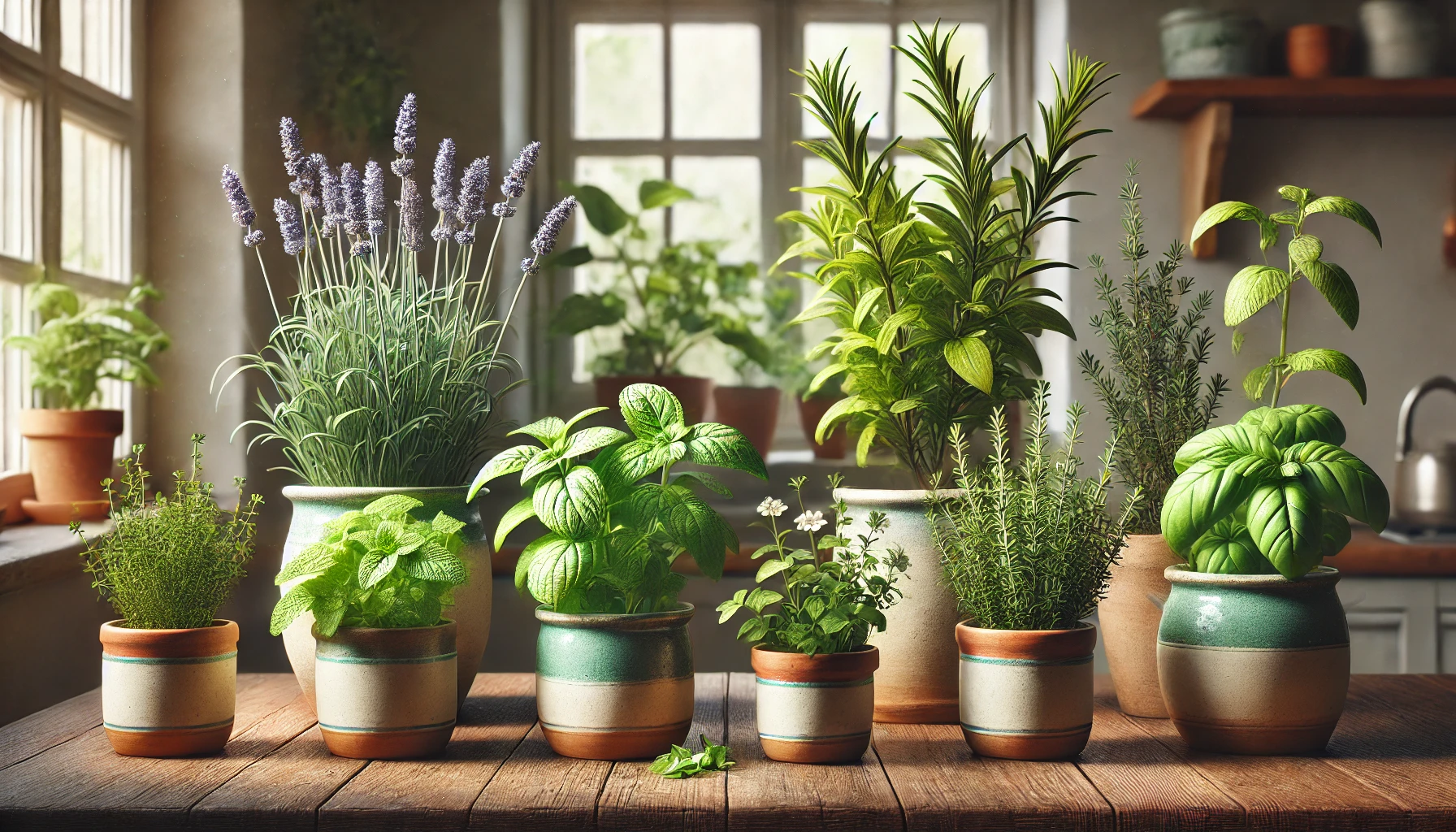Growing fragrant herbs in containers is a fantastic way to bring fresh, aromatic plants into your home, balcony, or garden. These herbs not only enhance your cooking, but they also provide pleasant scents, natural air purification, and even insect-repellent properties. Whether you prefer sweet, citrusy, or earthy aromas, there’s a perfect herb for your container garden.
This guide will introduce you to the most fragrant herbs, how to grow them successfully in pots, and how to use them for maximum enjoyment.
Why Grow Fragrant Herbs in Containers?
1. Space-Saving and Portable
- Containers allow you to grow herbs even in small spaces like balconies, patios, or kitchen counters.
- Easily move your herbs indoors during colder months or to sunnier spots as needed.
2. Enhance Indoor and Outdoor Air Quality
- Many fragrant herbs act as natural air fresheners.
- Their essential oils help purify the air and promote relaxation.
3. Natural Pest Repellents
- Some herbs deter mosquitoes, flies, and other insects, making them perfect for patios and doorways.
4. Multi-Purpose Use
- Use these herbs for cooking, teas, essential oils, homemade beauty products, and aromatherapy.
The Most Fragrant Herbs for Container Gardening
1. Lavender (Lavandula spp.)
Scent Profile: Sweet, floral, and calming with woody undertones.
Why Grow It?
- Known for its relaxing aroma, lavender is widely used in essential oils, teas, and homemade soaps.
- Deters mosquitoes and moths, making it great for patios and windowsills.
Growing Tips:
- Sunlight: Needs 6-8 hours of full sun.
- Soil: Prefers well-draining, sandy soil.
- Watering: Water sparingly, allowing soil to dry between watering.
- Best Container: Clay or terracotta pot to prevent root rot.
How to Use:
- Add dried lavender buds to sachets for natural air fresheners.
- Brew into calming herbal teas.
- Infuse into homemade soaps and candles.
2. Rosemary (Rosmarinus officinalis)
Scent Profile: Strong, pine-like, with earthy and citrusy notes.
Why Grow It?
- One of the most intensely fragrant herbs, rosemary’s essential oils are used in aromatherapy and cooking.
- Acts as a natural insect repellent.
Growing Tips:
- Sunlight: Needs 6-8 hours of direct sunlight.
- Soil: Well-draining potting mix with added sand.
- Watering: Allow soil to dry out between watering.
- Best Container: Deep pot to accommodate strong roots.
How to Use:
- Crush fresh rosemary leaves for instant aromatherapy.
- Use in roasted meats, potatoes, and homemade bread.
- Dry sprigs to create scented sachets for drawers.
3. Mint (Mentha spp.)
Scent Profile: Cool, refreshing, and slightly sweet.
Why Grow It?
- One of the most refreshing-smelling herbs, mint is perfect for teas, desserts, and cocktails.
- Repels flies, ants, and mosquitoes.
Growing Tips:
- Sunlight: Prefers partial sun to full sun.
- Soil: Rich, moist, and well-draining.
- Watering: Keep consistently moist, but avoid soggy soil.
- Best Container: Wide, shallow pot (mint spreads aggressively).
How to Use:
- Add to iced tea, mojitos, or lemonade.
- Rub leaves between your fingers for instant fresh scent.
- Dry leaves for homemade herbal tea blends.
4. Lemon Balm (Melissa officinalis)
Scent Profile: Bright, lemony with a hint of mint.
Why Grow It?
- A fantastic stress-relieving herb with a fresh, citrus scent.
- Deters mosquitoes and attracts bees to pollinate other plants.
Growing Tips:
- Sunlight: Prefers partial sun to full sun.
- Soil: Well-draining, rich in organic matter.
- Watering: Keep evenly moist but not soggy.
- Best Container: Medium-sized pot for easy pruning.
How to Use:
- Add to herbal teas for relaxation.
- Infuse in bathwater for a calming effect.
- Crush leaves and rub on skin as a natural mosquito repellent.
5. Thyme (Thymus spp.)
Scent Profile: Earthy, slightly floral, with a peppery touch.
Why Grow It?
- A culinary and medicinal herb, thyme is used in cooking, teas, and essential oils.
- Natural antibacterial properties make it great for herbal remedies.
Growing Tips:
- Sunlight: Needs 6-8 hours of sunlight.
- Soil: Well-draining, sandy soil.
- Watering: Water sparingly—thyme thrives in drier conditions.
- Best Container: Shallow, wide pot for spreading growth.
How to Use:
- Add fresh thyme to soups, roasts, and stews.
- Brew into a soothing herbal tea for colds.
- Dry sprigs for potpourri and scented sachets.
6. Basil (Ocimum basilicum)
Scent Profile: Sweet, slightly spicy, and rich.
Why Grow It?
- A staple in Italian and Thai cooking, basil’s strong scent enhances many dishes.
- Acts as a natural mosquito repellent.
Growing Tips:
- Sunlight: Needs 6-8 hours of sunlight.
- Soil: Rich, moist, well-draining.
- Watering: Keep soil evenly moist.
- Best Container: Medium pot, regularly pruned for bushy growth.
How to Use:
- Use fresh basil in pesto, pasta, and salads.
- Add to herbal teas for a mild, relaxing flavor.
- Crush leaves for an instant burst of fresh aroma.
How to Maintain Fragrant Herbs in Containers
1. Prune Regularly for Maximum Aroma
- Cutting herbs encourages new growth and stronger scents.
- Pinch off flower buds to keep the leaves flavorful.
2. Keep Soil Healthy
- Use well-draining potting mix to prevent root rot.
- Add organic compost or liquid fertilizer every 4-6 weeks.
3. Provide the Right Light
- Most fragrant herbs need 6-8 hours of sunlight.
- Use LED grow lights if growing indoors.
4. Harvest Frequently
- The more you harvest, the more the plant produces fresh leaves.
Conclusion: Enjoying Fragrant Herbs in Your Home
Growing fragrant herbs in containers brings freshness, beauty, and natural aromas to your home. Whether you choose soothing lavender, zesty lemon balm, or refreshing mint, these herbs provide culinary, medicinal, and aromatic benefits. By following proper care techniques, you’ll have a thriving herb garden that delights the senses all year long.

